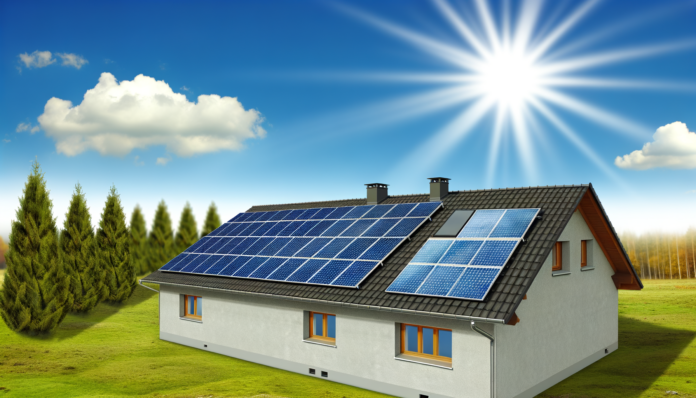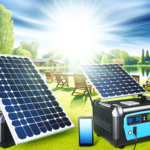Introduction to Solar Power
What is Solar Power?
Solar power is the energy harnessed from the sun’s rays, which can be converted into electricity or heat. This renewable energy source is captured through various technologies, including photovoltaic (PV) cells, solar thermal systems, and passive solar heating. **Photovoltaic cells** convert sunlight directly into electricity, while **solar thermal technology** uses the sun’s heat to produce hot water or steam. **Passive solar heating** involves designing buildings to naturally collect and store solar energy for heating purposes.
Brief History of Solar Energy
The concept of harnessing solar energy dates back to ancient civilizations, which used sunlight to light fires with magnifying glasses. However, the modern era of solar power began in the 19th century. In 1839, French physicist Alexandre Edmond Becquerel discovered the photovoltaic effect, which laid the groundwork for solar cells. The first practical photovoltaic cell was developed in 1954 by Bell Labs, marking a significant milestone in solar technology. Over the decades, advancements in materials and technology have made solar power more efficient and accessible, leading to its widespread adoption today.
Current Trends in Solar Power Adoption
In recent years, solar power has seen exponential growth, driven by technological advancements, decreasing costs, and increasing environmental awareness. Governments worldwide are implementing policies and incentives to promote solar energy adoption. For instance, many countries offer tax credits, rebates, and feed-in tariffs to encourage both residential and commercial solar installations. Additionally, innovations such as **Hybrid Passivated Back Contact (HPBC) technology** are pushing the boundaries of solar efficiency, making it a more viable option for a broader range of applications. The integration of solar power with smart home technologies and energy storage solutions is also gaining traction, further enhancing its appeal and practicality.
As we continue to innovate and invest in solar technology, the future looks bright for this sustainable energy source.
Environmental Benefits
Reduction in Carbon Footprint
Solar power is a clean and renewable energy source that significantly reduces carbon emissions. Unlike fossil fuels, which release large amounts of carbon dioxide (CO2) and other greenhouse gases into the atmosphere, solar energy production generates electricity without emitting harmful pollutants. By harnessing the power of the sun, solar panels help mitigate climate change and reduce the overall carbon footprint. This reduction in greenhouse gas emissions is crucial for slowing global warming and protecting the environment for future generations.
Decreased Air and Water Pollution
The environmental benefits of solar power extend beyond reducing carbon emissions. Traditional energy sources, such as coal and natural gas, contribute to air and water pollution through the release of harmful substances like sulfur dioxide, nitrogen oxides, and particulate matter. These pollutants can cause respiratory problems, cardiovascular diseases, and other health issues. Solar energy, on the other hand, produces electricity without emitting these harmful pollutants, leading to cleaner air and healthier communities.
Moreover, solar power does not require water for electricity generation, unlike conventional power plants that consume vast amounts of water for cooling and other processes. This conservation of water resources is particularly important in arid regions and areas facing water scarcity. By reducing the demand for water in energy production, solar power helps protect aquatic ecosystems and ensures the availability of clean water for other essential uses.
Conservation of Natural Resources
Solar energy contributes to the conservation of natural resources by reducing the reliance on finite fossil fuels. Coal, oil, and natural gas are non-renewable resources that take millions of years to form and are being depleted at an alarming rate. The extraction and transportation of these fuels also have significant environmental impacts, including habitat destruction, soil erosion, and oil spills.
In contrast, solar power harnesses the abundant and inexhaustible energy of the sun. By investing in solar energy, we can reduce the need for mining and drilling activities that harm the environment. Additionally, solar panels have a long lifespan, often exceeding 25 years, and require minimal maintenance. This durability and low operational cost make solar power a sustainable and eco-friendly energy solution.
In summary, the environmental benefits of solar power are manifold. By reducing carbon emissions, decreasing air and water pollution, and conserving natural resources, solar energy plays a vital role in promoting environmental sustainability and protecting the planet for future generations. Embracing solar power is a crucial step towards a cleaner, healthier, and more sustainable world.
Economic Advantages
Lower Energy Bills
One of the most compelling economic advantages of solar power is the potential for significant cost savings on energy bills. Once solar panels are installed, they generate electricity with minimal operating costs. This means that homeowners and businesses can drastically reduce their monthly electricity expenses. According to the National Renewable Energy Laboratory, every dollar saved on electric bills through solar energy increases the value of a home by $20. Additionally, homes equipped with solar panels tend to sell for approximately 4% higher than those without, making solar installations a financially savvy investment.
Government Incentives and Tax Credits
To encourage the adoption of solar energy, many governments offer a variety of incentives, tax credits, and rebates. These financial incentives can significantly offset the initial costs of installing solar panels, making the transition to solar energy more accessible for a broader range of people. For instance, in the United States, the federal government offers the Investment Tax Credit (ITC), which allows homeowners to deduct a significant percentage of their solar installation costs from their federal taxes. Many states and local governments also provide additional incentives, further reducing the financial burden and enhancing the appeal of solar energy.
Job Creation in the Solar Industry
The rapid growth of the solar industry has led to substantial job creation and economic growth. From manufacturing and installation to maintenance and research, the solar sector offers a wide array of employment opportunities. According to the Solar Foundation, the solar industry employs hundreds of thousands of workers in the United States alone, and this number is expected to grow as investments in solar energy continue to rise. These jobs not only contribute to economic stability but also foster innovation and technological advancements within the renewable energy sector.
In summary, the economic advantages of solar power are multifaceted, ranging from significant cost savings on energy bills to lucrative government incentives and robust job creation. By investing in solar energy, individuals and communities can enjoy long-term financial benefits while contributing to a more sustainable and resilient energy future.
Technological Advancements
Efficiency Improvements in Solar Panels
The efficiency of solar panels has seen remarkable advancements over the past few decades. Early solar panels had efficiency rates of around 6%, but modern panels can achieve efficiencies exceeding 22%. This leap in efficiency is largely due to innovations in materials and cell design. For instance, the development of multi-junction solar cells, which layer multiple semiconductor materials to capture a broader spectrum of sunlight, has significantly boosted efficiency. Additionally, the use of novel materials such as perovskites and organic photovoltaics has opened new avenues for enhancing solar cell performance. These materials not only improve efficiency but also reduce production costs, making solar power more accessible to a wider audience.
Innovations in Solar Storage Solutions
One of the critical challenges of solar energy is its intermittency—solar panels only generate electricity when the sun is shining. However, advancements in solar storage solutions are addressing this issue effectively. Modern solar batteries, such as lithium-ion and flow batteries, have become more efficient and affordable. These batteries store excess energy generated during the day for use during nighttime or cloudy periods, ensuring a consistent power supply. Moreover, the integration of smart grid technology allows for better energy management and distribution, optimizing the use of stored solar energy. Innovations like these are crucial for enhancing the reliability and resilience of solar power systems.
Integration with Smart Home Technologies
The integration of solar power with smart home technologies is revolutionizing how we manage and consume energy. Smart home systems can now seamlessly incorporate solar panels and storage solutions, allowing homeowners to monitor and control their energy usage in real-time. For example, smart inverters can optimize the conversion of solar energy into usable electricity, while smart thermostats and appliances can adjust their operation based on the availability of solar power. Additionally, home energy management systems can predict energy production and consumption patterns, enabling more efficient use of solar energy. This integration not only enhances energy efficiency but also provides homeowners with greater control and flexibility over their energy consumption.
In summary, technological advancements in solar panel efficiency, storage solutions, and smart home integration are driving the solar power industry forward. These innovations are making solar energy more efficient, reliable, and accessible, paving the way for a sustainable energy future.
Practical Applications
Solar Power for Homes
Solar power has become an increasingly popular choice for homeowners looking to reduce their energy bills and carbon footprint. By installing solar panels on rooftops, homeowners can harness the sun’s energy to generate electricity for their daily needs. This not only reduces reliance on traditional power grids but also offers significant cost savings over time.
**Key benefits of solar power for homes include:**
– **Lower energy bills:** Solar panels can significantly reduce or even eliminate monthly electricity costs.
– **Increased property value:** Homes equipped with solar energy systems often see an increase in market value.
– **Energy independence:** Homeowners can produce their own electricity, reducing dependence on external power sources.
– **Environmental impact:** Solar energy is a clean, renewable resource that helps reduce greenhouse gas emissions.
Moreover, advancements in solar technology have made it easier and more affordable for homeowners to install and maintain solar systems. With various financing options and government incentives available, the initial investment in solar power can be offset, making it a viable option for many households.
Portable Solar Solutions for Outdoor Activities
For those who love outdoor activities, portable solar solutions offer a convenient and eco-friendly way to power devices on the go. Whether you’re camping, hiking, or enjoying a day at the beach, portable solar panels and solar-powered gadgets can keep your electronic devices charged without the need for traditional power sources.
**Popular portable solar solutions include:**
– **Solar chargers:** Compact and lightweight, these devices can charge smartphones, tablets, and other small electronics.
– **Solar-powered lanterns:** Ideal for camping trips, these lanterns provide reliable lighting without the need for batteries.
– **Solar backpacks:** Equipped with built-in solar panels, these backpacks can charge devices while you’re on the move.
These portable solar solutions are not only practical but also promote sustainable living by reducing the need for disposable batteries and minimizing environmental impact.
Solar Energy in Remote and Off-Grid Locations
In remote and off-grid locations, access to reliable electricity can be a significant challenge. Solar energy offers a viable solution for powering homes, schools, and businesses in areas where traditional power infrastructure is unavailable or unreliable.
**Advantages of solar energy in remote locations include:**
– **Accessibility:** Solar panels can be installed in virtually any location with adequate sunlight, providing a reliable source of electricity.
– **Cost-effectiveness:** In many cases, solar energy is more affordable than extending power lines to remote areas.
– **Sustainability:** Solar power is a renewable resource that reduces dependence on fossil fuels and minimizes environmental impact.
Solar energy systems can be customized to meet the specific needs of remote communities, from small-scale installations for individual homes to larger systems that power entire villages. Additionally, advancements in solar storage solutions, such as batteries, ensure a continuous power supply even when the sun isn’t shining.
In conclusion, the practical applications of solar power are vast and varied, offering solutions for homeowners, outdoor enthusiasts, and remote communities alike. By harnessing the power of the sun, we can reduce our reliance on traditional energy sources, lower our environmental impact, and create a more sustainable future.
Challenges and Solutions
Overcoming Initial Installation Costs
The initial installation cost of solar power systems can be a significant barrier for many consumers. A typical residential solar panel system can cost between $15,000 to $25,000, which may be prohibitive for some homeowners. However, there are several ways to mitigate these costs:
- Government Incentives and Tax Credits: Many governments offer incentives and tax credits to reduce the upfront costs of solar installations. For instance, the federal solar tax credit in the United States allows homeowners to deduct a significant percentage of the installation cost from their federal taxes.
- Financing Options: Various financing options, such as solar loans and leases, can spread the cost over several years, making it more manageable. Some companies also offer power purchase agreements (PPAs), where consumers pay for the electricity generated rather than the panels themselves.
- Long-Term Savings: Despite the high initial costs, solar panels can lead to substantial long-term savings on electricity bills. Most consumers break even on their investment within six to ten years, after which they enjoy free electricity for the remaining lifespan of the system.
Addressing Intermittency and Storage Issues
Solar power generation is inherently intermittent, as it depends on sunlight, which is not available at night and can be less effective on cloudy days. This intermittency poses a challenge for consistent energy supply. However, several solutions are being developed and implemented:
- Solar Battery Storage: Advances in battery technology have made it possible to store excess solar energy generated during the day for use at night or during cloudy periods. Solar batteries, such as those offered by Tesla and LG, are becoming more efficient and affordable.
- Grid Integration: Many solar systems are designed to work in conjunction with the traditional power grid. During periods of low solar generation, homes can draw power from the grid, and during periods of excess generation, they can feed power back into the grid, often earning credits through net metering.
- Hybrid Systems: Combining solar power with other renewable energy sources, such as wind or hydro, can provide a more stable and reliable energy supply. Hybrid systems can balance the intermittency of solar power with the consistency of other energy sources.
Maintenance and Longevity of Solar Systems
While solar panels are generally low-maintenance, they do require some upkeep to ensure optimal performance and longevity. Here are some considerations and solutions:
- Regular Cleaning: Dust, dirt, and debris can accumulate on solar panels, reducing their efficiency. Regular cleaning, either by the homeowner or a professional service, can help maintain optimal performance. An annual inspection or cleaning typically costs around $150.
- Monitoring Systems: Many modern solar installations come with monitoring systems that allow homeowners to track the performance of their panels in real-time. These systems can alert users to any issues that may require maintenance.
- Warranties and Guarantees: Most solar panels come with warranties that cover performance and defects for 20-25 years. These warranties provide peace of mind and financial protection against potential issues.
By addressing these challenges through innovative solutions and strategic planning, the adoption of solar power can become more accessible and reliable, paving the way for a sustainable energy future.
Future of Solar Power
Emerging Technologies and Innovations
The future of solar power is bright, thanks to continuous advancements in technology and innovative solutions. One of the most promising developments is the advent of *perovskite solar cells*. These cells offer higher efficiency rates and lower production costs compared to traditional silicon-based cells. Additionally, *bifacial solar panels*, which capture sunlight on both sides, are gaining traction for their ability to generate more electricity from the same surface area.
Another exciting innovation is the integration of *solar power with blockchain technology*. This allows for more transparent and efficient energy trading, enabling consumers to buy and sell excess solar energy directly. Furthermore, *solar skins*—customizable solar panels that blend seamlessly with the aesthetics of buildings—are making solar installations more visually appealing, encouraging wider adoption.
Global Trends and Predictions
The global landscape for solar power is evolving rapidly. According to recent reports, solar energy is expected to account for nearly one-third of the world’s electricity by 2050. Countries like China, India, and the United States are leading the charge, investing heavily in solar infrastructure and research.
In Europe, the push for *carbon neutrality* by 2050 has accelerated the adoption of solar power, with countries like Germany and Spain setting ambitious targets for solar capacity. Meanwhile, in developing nations, solar power is emerging as a viable solution for electrification, providing clean energy to remote and off-grid areas.
The trend towards *decentralized energy systems* is also gaining momentum. Community solar projects and microgrids are becoming more common, allowing local communities to generate and manage their own electricity. This not only enhances energy security but also fosters economic development.
The Role of Solar Power in Sustainable Living
Solar power is poised to play a crucial role in promoting sustainable living. By reducing reliance on fossil fuels, solar energy helps mitigate climate change and decrease environmental pollution. The integration of solar power with *smart home technologies* is making it easier for households to monitor and optimize their energy consumption, leading to more efficient and sustainable lifestyles.
Moreover, solar power is contributing to the development of *sustainable cities*. Urban planners are increasingly incorporating solar panels into building designs, public spaces, and transportation systems. For instance, solar-powered electric vehicle charging stations are becoming more prevalent, supporting the transition to cleaner transportation.
In agriculture, solar power is being used to run irrigation systems, reducing the carbon footprint of farming practices. Additionally, *solar desalination* plants are providing clean drinking water in arid regions, addressing both energy and water scarcity issues.
In conclusion, the future of solar power is filled with promise and potential. With ongoing technological advancements, supportive global trends, and its pivotal role in sustainable living, solar energy is set to become a cornerstone of the world’s energy landscape. By embracing these innovations and trends, we can pave the way for a cleaner, more sustainable future.






